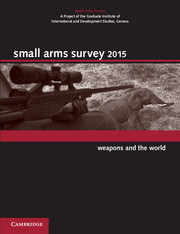Book contents
- Frontmatter
- FOREWORD
- Contents
- ABOUT THE SMALL ARMS SURVEY
- Notes to readers
- ACKNOWLEDGEMENTS
- Introduction
- Chapter 1 In the Line of Fire: Elephant and Rhino Poaching in Africa pages 6 to 19
- Chapter 1 In the Line of Fire: Elephant and Rhino Poaching in Africa pages 20 to 35
- Chapter 2 Digging for Trouble: Violence and Frontier Urbanization
- Chapter 3 One Meeting after Another: UN Process Update
- Chapter 4 Trade Update: After the ‘Arab Spring’ pages 84 to 91
- Chapter 4 Trade Update: After the ‘Arab Spring’ pages 92 to 123
- Chapter 5 Less ‘Bang’ for the Buck: Stockpile Management in South-east Europe
- Chapter 6 Expanding Arsenals: Insurgent Arms in Northern Mali pages 156 to 169
- Chapter 6 Expanding Arsenals: Insurgent Arms in Northern Mali pages 170 to 185
- Chapter 7 Waning Cohesion: The Rise and Fall of the FDLR–FOCA pages 186 to 198
- Chapter 7 Waning Cohesion: The Rise and Fall of the FDLR–FOCA pages 199 to 215
- Chapter 8 Stockpiles at Sea: Floating Armouries in the Indian Ocean
- Chapter 9 Unprotected: Young People in Post-conflict Burundi pages 242 to 249
- Chapter 9 Unprotected: Young People in Post-conflict Burundi pages 250 to 267
- INDEX
Introduction
Published online by Cambridge University Press: 05 July 2015
- Frontmatter
- FOREWORD
- Contents
- ABOUT THE SMALL ARMS SURVEY
- Notes to readers
- ACKNOWLEDGEMENTS
- Introduction
- Chapter 1 In the Line of Fire: Elephant and Rhino Poaching in Africa pages 6 to 19
- Chapter 1 In the Line of Fire: Elephant and Rhino Poaching in Africa pages 20 to 35
- Chapter 2 Digging for Trouble: Violence and Frontier Urbanization
- Chapter 3 One Meeting after Another: UN Process Update
- Chapter 4 Trade Update: After the ‘Arab Spring’ pages 84 to 91
- Chapter 4 Trade Update: After the ‘Arab Spring’ pages 92 to 123
- Chapter 5 Less ‘Bang’ for the Buck: Stockpile Management in South-east Europe
- Chapter 6 Expanding Arsenals: Insurgent Arms in Northern Mali pages 156 to 169
- Chapter 6 Expanding Arsenals: Insurgent Arms in Northern Mali pages 170 to 185
- Chapter 7 Waning Cohesion: The Rise and Fall of the FDLR–FOCA pages 186 to 198
- Chapter 7 Waning Cohesion: The Rise and Fall of the FDLR–FOCA pages 199 to 215
- Chapter 8 Stockpiles at Sea: Floating Armouries in the Indian Ocean
- Chapter 9 Unprotected: Young People in Post-conflict Burundi pages 242 to 249
- Chapter 9 Unprotected: Young People in Post-conflict Burundi pages 250 to 267
- INDEX
Summary
We tend to approach the issues of small arms proliferation and armed violence in terms of people and the relations between them: perpetrators and victims, buyers and sellers, groups in conflict with one another. This people-centred approach is understandable because our ultimate aims are to reduce human suffering and improve human security. But if the focus is too narrow, it can obscure the broader picture.
This year, the Small Arms Survey 2015: Weapons and the World aims to provide several pieces of that broader picture, examining small arms and armed violence from contrasting, but complementary angles. Its first section explores two specific aspects of an emerging issue area, namely the environment and small arms. A second section, titled ‘weapons, markets, and measures’, looks at small arms markets and control challenges. The final section of the 2015 Survey focuses on armed actors.
THE ENVIRONMENT AND SMALL ARMS
This is not the first time the Small Arms Survey has stepped back from the specifics of arms markets and armed violence to examine broader socio-economic, political, and cultural influences. The connections between small arms and the natural world, however, remain largely unexplored, even though in some cases they are lying in plain sight. Many of the world's battlefields, for example, are scarred with the physical by-products of ammunition use, in the form of lead and, in some cases, depleted uranium.
On a much broader scale, the many ways in which environmental factors can trigger, sustain, and shape armed conflicts are gaining increasing attention. Resource constraints have provoked violence throughout history. In the 21st century, overpopulation, increasing urbanization, resource depletion, and climate-linked change, including drought-induced privation, are adding fuel to the fire.
Global climate change is now seen as the most pressing of all environmental problems. The year 2014 was the warmest ever recorded (NASA, 2015), and there are concerns regarding the impact of climate change on human interactions— including on underlying causes of armed conflict, as well as on actual fighting. In tropical conflict areas, for example, fighting traditionally stops during the rainy season, only to resume when the soil hardens enough for vehicles to navigate unpaved roads
- Type
- Chapter
- Information
- Small Arms Survey 2015Weapons and the World, pp. 1 - 5Publisher: Cambridge University PressPrint publication year: 2015



